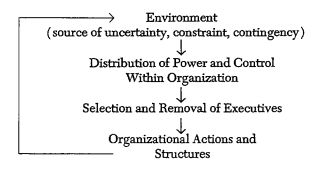There are a variety of possible mechanisms by which the organization’s context can come to influence its structure and actions. While the environment (or, more correctly, actions of others in the environment) may present the contingencies that create problems for the organization, those actions must be enacted and considered by organizational members. In Chapter Four we discussed the enactment process and noted that the link between context and organizational perceptions of that context was itself partly indeterminate.
In this chapter we will present a model of one mechanism by which the environment is linked to organizational change and action. The model suggests that the relationship between environments and organizations is not random but is indeterminate, and that the very indeterminancy of environmental effects on organizations is potentially explainable. The model concerns the effects of executive succession in organizations on organizational change. By succession we mean the removal of one executive and the selection of another. We argue that both the removal and selection of top administrators is affected by the organization’s context. The argument can be briefly summarized: (1) the environmental context, with its contingencies, uncertainties, arid interdependencies, influences the distribution of power and control within the organization; (2) the distribution of power and control within the organization affects the tenure and selection of major organizational administrators; (3) organizational policies and structures are results of decisions affected by the distribution of power and control; and (4) administrators who control organizational activities affect those activities and resultant structures. Executives are a source of control, and it matters who is in control because control determines organizational activities. The environment affects organizational activi- ties because it affects the distribution of control within the organization.
The mechanism by which organizational environments may affect organizations can be represented by the following diagram:

In specifying this model of organizational change, we naturally recognize that it is only one possible model. We use it to highlight three causal linkages that may lead from environmental factors to organizational characteristics. First, there is the link between the environment, a source of uncertainty and constraint, and the distribution of power and control within the organization. Second, there is the link between the distribution of power and control and the choice of executives and their tenure. Finally, there is the relationship between organizational administrators and the actions and structure of organizations. Given this causal sequence, one may not observe a perfect relationship between organizational actions and structures and the environment for several reasons. First, since each intermediate variable undoubtedly has other causes besides those specified, the relationship between environments and organizational actions and structures may be attenuated by these other factors. Second, because of the linked nature of the causal process, any indeterminacy or error in the process will be magnified because of the intermediate steps that link environments with organizations. For instance, even if each of the causal link* were as strong as a .8 correlation, the overall correlation between environmental dimensions and organizational characteristics would be only .51. It is not surprising, therefore, that researchers often fail to find strong relationships between environmental characteristics and organizational outcomes.
The model indicates that organizational actions result from political processes within organizations, a view compatible with the political economy framework proposed by Zald (1970a; 1970b). As such, the model is inconsistent with theoretical positions that maintain that organizational actions and structures are inevitably constrained by environmental requirements. Such a position has been maintained by microeconomic theories of organizations operating in perfectly competitive environments and by the related ecological or natural selection models (e.g., Winter, 1971). In either model, the organization comes to match the environmental requirements, or else it fails. If, in fact, organizations were tightly linked to their environments, we could more easily neglect the intervening steps presented in the above model. Such intervening processes would be of interest only for their own sake; in equilibrium, it would be true that organizational results would be predicted by environmental factors. It is unlikely that organizations are so tightly constrained by their environments (Child, 1972). Organizations are only loosely coupled with their environments, and we believe that power is one important variable intervening between environments and organizations.
Source: Pfeffer Jeffrey, Salancik Gerald (2003), The External Control of Organizations: A Resource Dependence Perspective, Stanford Business Books; 1st edition
